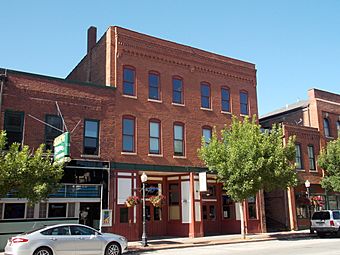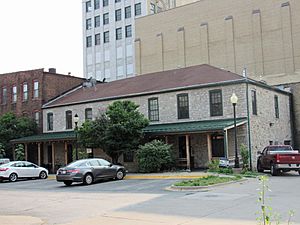Woeber Carriage Works facts for kids
|
Woeber Carriage Works
|
|
|
U.S. Historic district
Contributing property |
|
 |
|
| Location | 312 W. 3rd St. Davenport, Iowa |
|---|---|
| Built | 1857 (rear), 1881 |
| Architect | John C. Cochrane |
| Architectural style | Italianate |
| Part of | Davenport Downtown Commercial Historic District (ID100005546) |
Quick facts for kids Significant dates |
|
| Added to NRHP | September 11, 2020 |
The Woeber Carriage Works is an old building in Davenport, Iowa. It's also known by other names, like the G. Hager & Co. Carriage Works and the Davenport Plow Works. This building is important because it has a long history in the city.
It was officially recognized as a historic place in Davenport on November 15, 2000. Later, in 2020, it was added to the National Register of Historic Places. This means it's a special building that helps tell the story of the area.
Contents
What Is the History of the Woeber Carriage Works?
The main part of the Woeber Carriage Works building was built in 1881. It was first used by a company called the Davenport Plow Works. Before this building was here, the First Presbyterian Church stood on this spot.
Records from 1881 show that the Davenport Plow Works was located at 310-324 West 3rd Street. Maps from 1886 tell us more about the building at 312 West 3rd Street. The front part of the building had a machine shop, assembly area, and storage on all three floors.
Behind the main building, there's an older stone structure built in 1857. This part was used for polishing and grinding on the first floor. The second floor was used for storage. The rest of the Davenport Plow Works was in the building next door.
Who Owned the Building After the Plow Works?
After the Davenport Plow Works closed down, a lawyer and real estate investor named C.A. Ficke bought the building in 1889. He fixed it up so he could rent it out to different businesses.
Over the years, many different companies used the building. From 1898 to 1910, Peter A. Reimers and James Larkin had their businesses there. Peter A. Reimers made things like cornices, skylights, and metal roofs.
Later, other businesses moved in, including the Benner Tea Co. (1915–1918) and the Federal System of Bakeries (1920). The Chicago Butchers Market Co. (1925), Safe-Way Markets (1930), and Atlas Cigar (1940) also used the building. Today, a nightclub called the Carriage Haus is located there.
What Does the Woeber Carriage Works Look Like?
The Woeber Carriage Works building has three stories. It is made of brick and built in a style called Italianate. This style often includes decorative details and tall windows. The building likely has a strong stone foundation.
There is also a two-story structure made of stone attached to the back. The brick part of the building is shaped like a rectangle and has a flat roof.
What Are the Main Features of the Building?
The front of the building, called the façade, is divided into three main parts. These are the storefront, the upper wall, and the cornice (the decorative top edge). The building still has its original two entrances. A strong steel beam separates the storefront from the two upper floors.
The windows on the second and third floors are arranged in two groups of three. This design makes the two sides of the building stand out. Each window has a curved top and a stone sill at the bottom. The cornice at the very top is made of bricks in a special pattern.
The stone building at the back is a simple, rectangular structure. It has a hipped roof, which slopes down on all four sides. The most noticeable features of this part of the building are its many double-hung windows.
What Was the Woeber Brothers Carriage Works Company?
The Woeber Brothers Carriage Works company was started by Adam Woeber in 1872. He took over a wagon-making business in Davenport that his brothers had been running since the 1850s.
This company was known for building strong wagons for businesses. They also made other types of vehicles and heavy equipment.




